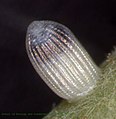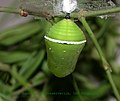Tirumala septentrionis
| Dark blue tiger | |
|---|---|

| |

| |
| Underside both T. s. dravidarum Kerala, India | |
| Scientific classification | |
| Kingdom: | Animalia |
| Phylum: | Arthropoda |
| Class: | Insecta |
| Order: | Lepidoptera |
| Family: | Nymphalidae |
| Genus: | Tirumala |
| Species: | T. septentrionis
|
| Binomial name | |
| Tirumala septentrionis (Butler, 1874)
| |
Tirumala septentrionis, the dark blue tiger,[1][2] is a danaid butterfly found in the Indian subcontinent and Southeast Asia.[1][2]
Description[]
Closely resembles Tirumala limniace, Cramer, but is always sufficiently distinct to be easily recognized, even on the wing. From T. limniace it differs on the upperside in the ground colour being darker and the semihyaline markings narrower, more distinct, and of a bluer tint, In the forewing, in interspace 1 the two streaks are narrower, never coalescent, the upper one forming an oval detached spot; the short streaks above vein 5 are outwardly never truncate, always acute. In the hindwing the two streaks if the discoidal cell united at base are wide apart at their apices, the lower one never formed into a hook. On the underside this species is generally darker, the apex of the forewing and the whole of the ground colour of the hindwing not being of the conspicuous golden brown that they are in T. limniace.[3][4]
Wingspan 80–115 mm.
Distribution[]
The Himalayas from Simla to Sikkim, into Assam, Myanmar, Cambodia and Southeast Asia; Orissa; West Bengal, southern India, the Western Ghats and Nilgiris; Sri Lanka.[1][2]
Habits[]
This species is one of the predominant species (78%) during the migratory season in southern India during which many species migrate. Both males and females appear to migrate in equal numbers.[5]
Life cycle[]
Caterpillar is similar to that of T. limniace (see Journal of the Bombay Natural History Society x, 1896, p. 240). It is said by MacKinnon and de Nicéville to feed on (Journal of the Bombay Natural History Society xi, 1807, p. 212).[3] Other species include ,[6] and Cocculus species.[7]

Egg

Caterpillar

Pupa

Adult

Male
See also[]
| Wikimedia Commons has media related to Tirumala septentrionis. |
References[]
- ^ a b c Varshney, R.K.; Smetacek, Peter (2015). A Synoptic Catalogue of the Butterflies of India. New Delhi: Butterfly Research Centre, Bhimtal & Indinov Publishing. p. 151. doi:10.13140/RG.2.1.3966.2164. ISBN 978-81-929826-4-9.
- ^ a b c Savela, Markku. "Tirumala septentrionis (Butler, 1874)". Lepidoptera and Some Other Life Forms. Retrieved July 3, 2018.
- ^ a b
 One or more of the preceding sentences incorporates text from this source, which is in the public domain: Bingham, Charles Thomas (1907). Fauna of British India. Butterflies Vol. 2. Taylor & Francis. p. 17.
One or more of the preceding sentences incorporates text from this source, which is in the public domain: Bingham, Charles Thomas (1907). Fauna of British India. Butterflies Vol. 2. Taylor & Francis. p. 17.
- ^
 One or more of the preceding sentences incorporates text from this source, which is in the public domain: Moore, Frederic (1890–1892). Lepidoptera Indica. Vol. I. London: Lovell Reeve and Co. pp. 34–36.
One or more of the preceding sentences incorporates text from this source, which is in the public domain: Moore, Frederic (1890–1892). Lepidoptera Indica. Vol. I. London: Lovell Reeve and Co. pp. 34–36.
- ^ Kunte, K. 2005. Species composition, sex-ratios and movement patterns in Danaine butterfly migrations in southern India. Journal of the Bombay Natural History Society 102(3):280-286
- ^ Nair, P. V. 2005. Cosmostigma racemosa, a new host plant record of the Dark Blue Tiger Butterfly Tirumala septentrionis from Kerala. Journal of the Bombay Natural History Society. 102(3):354
- ^ Gaden S. Robinson, Phillip R. Ackery, Ian J. Kitching, George W. Beccaloni and Luis M. Hernández HOSTS - A Database of the World's Lepidopteran Hostplants [1] Accessed October 2006
External links[]
- Tirumala (butterfly)
- Fauna of Southeast Asia
- Butterflies of Indochina
- Butterflies of Asia
- Insects of Thailand
- Butterflies described in 1874
- Taxa named by Arthur Gardiner Butler




